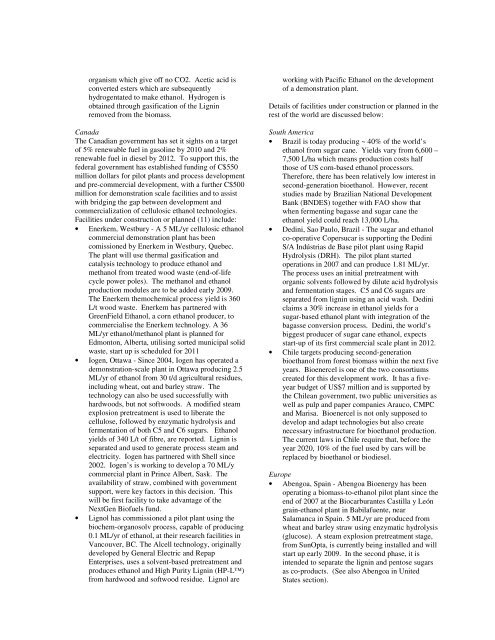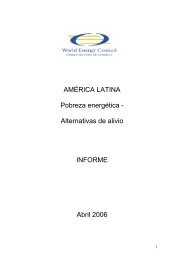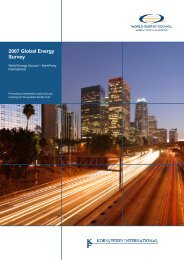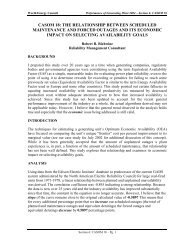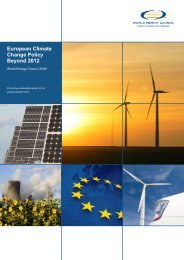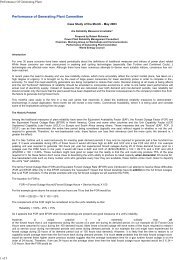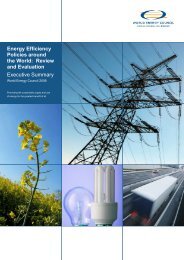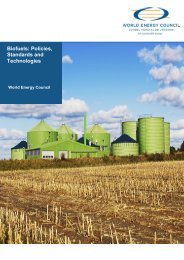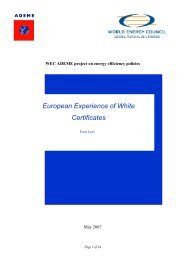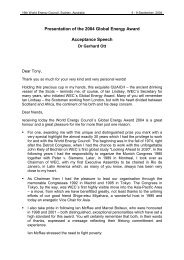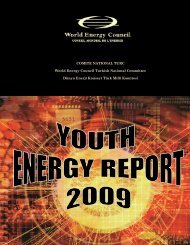Bioethanol – status report on bioethanol production from wood and ...
Bioethanol – status report on bioethanol production from wood and ...
Bioethanol – status report on bioethanol production from wood and ...
You also want an ePaper? Increase the reach of your titles
YUMPU automatically turns print PDFs into web optimized ePapers that Google loves.
organism which give off no CO2. Acetic acid is<br />
c<strong>on</strong>verted esters which are subsequently<br />
hydrogentated to make ethanol. Hydrogen is<br />
obtained through gasificati<strong>on</strong> of the Lignin<br />
removed <strong>from</strong> the biomass.<br />
Canada<br />
The Canadian government has set it sights <strong>on</strong> a target<br />
of 5% renewable fuel in gasoline by 2010 <strong>and</strong> 2%<br />
renewable fuel in diesel by 2012. To support this, the<br />
federal government has established funding of C$550<br />
milli<strong>on</strong> dollars for pilot plants <strong>and</strong> process development<br />
<strong>and</strong> pre-commercial development, with a further C$500<br />
milli<strong>on</strong> for dem<strong>on</strong>strati<strong>on</strong> scale facilities <strong>and</strong> to assist<br />
with bridging the gap between development <strong>and</strong><br />
commercializati<strong>on</strong> of cellulosic ethanol technologies.<br />
Facilities under c<strong>on</strong>structi<strong>on</strong> or planned (11) include:<br />
• Enerkem, Westbury - A 5 ML/yr cellulosic ethanol<br />
commercial dem<strong>on</strong>strati<strong>on</strong> plant has been<br />
comissi<strong>on</strong>ed by Enerkem in Westbury, Quebec.<br />
The plant will use thermal gasificati<strong>on</strong> <strong>and</strong><br />
catalysis technology to produce ethanol <strong>and</strong><br />
methanol <strong>from</strong> treated <strong>wood</strong> waste (end-of-life<br />
cycle power poles). The methanol <strong>and</strong> ethanol<br />
producti<strong>on</strong> modules are to be added early 2009.<br />
The Enerkem themochemical process yield is 360<br />
L/t <strong>wood</strong> waste. Enerkem has partnered with<br />
GreenField Ethanol, a corn ethanol producer, to<br />
commercialise the Enerkem technology. A 36<br />
ML/yr ethanol/methanol plant is planned for<br />
Edm<strong>on</strong>t<strong>on</strong>, Alberta, utilising sorted municipal solid<br />
waste, start up is scheduled for 2011<br />
• Iogen, Ottawa - Since 2004, Iogen has operated a<br />
dem<strong>on</strong>strati<strong>on</strong>-scale plant in Ottawa producing 2.5<br />
ML/yr of ethanol <strong>from</strong> 30 t/d agricultural residues,<br />
including wheat, oat <strong>and</strong> barley straw. The<br />
technology can also be used successfully with<br />
hard<strong>wood</strong>s, but not soft<strong>wood</strong>s. A modified steam<br />
explosi<strong>on</strong> pretreatment is used to liberate the<br />
cellulose, followed by enzymatic hydrolysis <strong>and</strong><br />
fermentati<strong>on</strong> of both C5 <strong>and</strong> C6 sugars. Ethanol<br />
yields of 340 L/t of fibre, are <str<strong>on</strong>g>report</str<strong>on</strong>g>ed. Lignin is<br />
separated <strong>and</strong> used to generate process steam <strong>and</strong><br />
electricity. Iogen has partnered with Shell since<br />
2002. Iogen’s is working to develop a 70 ML/y<br />
commercial plant in Prince Albert, Sask. The<br />
availability of straw, combined with government<br />
support, were key factors in this decisi<strong>on</strong>. This<br />
will be first facility to take advantage of the<br />
NextGen Biofuels fund.<br />
• Lignol has commissi<strong>on</strong>ed a pilot plant using the<br />
biochem-organosolv process, capable of producing<br />
0.1 ML/yr of ethanol, at their research facilities in<br />
Vancouver, BC. The Alcell technology, originally<br />
developed by General Electric <strong>and</strong> Repap<br />
Enterprises, uses a solvent-based pretreatment <strong>and</strong><br />
produces ethanol <strong>and</strong> High Purity Lignin (HP-L)<br />
<strong>from</strong> hard<strong>wood</strong> <strong>and</strong> soft<strong>wood</strong> residue. Lignol are<br />
working with Pacific Ethanol <strong>on</strong> the development<br />
of a dem<strong>on</strong>strati<strong>on</strong> plant.<br />
Details of facilities under c<strong>on</strong>structi<strong>on</strong> or planned in the<br />
rest of the world are discussed below:<br />
South America<br />
• Brazil is today producing ~ 40% of the world’s<br />
ethanol <strong>from</strong> sugar cane. Yields vary <strong>from</strong> 6,600 <str<strong>on</strong>g>–</str<strong>on</strong>g><br />
7,500 L/ha which means producti<strong>on</strong> costs half<br />
those of US corn-based ethanol processors.<br />
Therefore, there has been relatively low interest in<br />
sec<strong>on</strong>d-generati<strong>on</strong> <strong>bioethanol</strong>. However, recent<br />
studies made by Brazilian Nati<strong>on</strong>al Development<br />
Bank (BNDES) together with FAO show that<br />
when fermenting bagasse <strong>and</strong> sugar cane the<br />
ethanol yield could reach 13,000 L/ha.<br />
• Dedini, Sao Paulo, Brazil - The sugar <strong>and</strong> ethanol<br />
co-operative Copersucar is supporting the Dedini<br />
S/A Indústrias de Base pilot plant using Rapid<br />
Hydrolysis (DRH). The pilot plant started<br />
operati<strong>on</strong>s in 2007 <strong>and</strong> can produce 1.81 ML/yr.<br />
The process uses an initial pretreatment with<br />
organic solvents followed by dilute acid hydrolysis<br />
<strong>and</strong> fermentati<strong>on</strong> stages. C5 <strong>and</strong> C6 sugars are<br />
separated <strong>from</strong> lignin using an acid wash. Dedini<br />
claims a 30% increase in ethanol yields for a<br />
sugar-based ethanol plant with integrati<strong>on</strong> of the<br />
bagasse c<strong>on</strong>versi<strong>on</strong> process. Dedini, the world’s<br />
biggest producer of sugar cane ethanol, expects<br />
start-up of its first commercial scale plant in 2012.<br />
• Chile targets producing sec<strong>on</strong>d-generati<strong>on</strong><br />
<strong>bioethanol</strong> <strong>from</strong> forest biomass within the next five<br />
years. Bioenercel is <strong>on</strong>e of the two c<strong>on</strong>sortiums<br />
created for this development work. It has a fiveyear<br />
budget of US$7 milli<strong>on</strong> <strong>and</strong> is supported by<br />
the Chilean government, two public universities as<br />
well as pulp <strong>and</strong> paper companies Arauco, CMPC<br />
<strong>and</strong> Marisa. Bioenercel is not <strong>on</strong>ly supposed to<br />
develop <strong>and</strong> adapt technologies but also create<br />
necessary infrastructure for <strong>bioethanol</strong> producti<strong>on</strong>.<br />
The current laws in Chile require that, before the<br />
year 2020, 10% of the fuel used by cars will be<br />
replaced by <strong>bioethanol</strong> or biodiesel.<br />
Europe<br />
• Abengoa, Spain - Abengoa Bioenergy has been<br />
operating a biomass-to-ethanol pilot plant since the<br />
end of 2007 at the Biocarburantes Castilla y León<br />
grain-ethanol plant in Babilafuente, near<br />
Salamanca in Spain. 5 ML/yr are produced <strong>from</strong><br />
wheat <strong>and</strong> barley straw using enzymatic hydrolysis<br />
(glucose). A steam explosi<strong>on</strong> pretreatment stage,<br />
<strong>from</strong> SunOpta, is currently being installed <strong>and</strong> will<br />
start up early 2009. In the sec<strong>on</strong>d phase, it is<br />
intended to separate the lignin <strong>and</strong> pentose sugars<br />
as co-products. (See also Abengoa in United<br />
States secti<strong>on</strong>).


